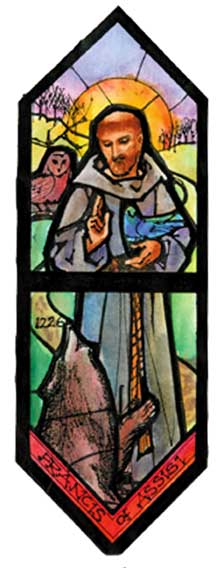|
|
|||

|
|||
Francis of Assisi
Window
 The new culture that arose after the fall of Rome reached its zenith in the high Middle Ages. Universities and Gothic architecture spread throughout Europe, as cities and trade once more flourished. As the population became more mobile, monasteries, whose stability and permanence were so necessary in earlier times, became less influential, and wandering preachers took center stage. The most famous of these itinerant preachers was Francis. As a young man, he dreamed of fame and glory, but illness ended his hopes and left him despondent. He often retreated to the ruins of the Church of St. Damian to pray. Then one day he heard Godís voice calling him to restore his church. Francisí enthusiasm returned, and he sold his horse and several bales of cloth belonging to his father to raise the needed funds. But his father treated him as a thief. When the bishop told Francis to repay his father, Francis responded dramatically, stating that he was the servant of God, and would return to his father even the clothes on his back. Then he stripped and walked out into the snowy woods, singing. He rebuilt St. Damianís (and several other churches) with his own hands, and joyfully embraced a life of poverty, even homelessness, in imitation of his beloved Jesus, as did the order of friars he founded. Eventually, Francisí life came to mirror Christís so closely that he even sought to follow him in death. Though martyrdom was never granted him, Francis was given the stigmata, the marks of Christís own death, and a taste of both his agony and joy. Soon after, Francisí health failed, and he was brought back to one of the chapels he had rebuilt in his youth. His last words are appropriate for us all: ďI have done my duty. Now, may Christ let you know yours. Welcome, sister Death.Ē Francisí reliance on God and deep humility were shown in his love for creation. He saw all creatures, from the greatest to the least, as brothers and sisters; for God sustains them all. In this spirit he preached to the birds, made peace with a wolf, and praised God for sun and moon, wind and water, and even death. (Our parish memorial garden is named for him.) Francisí hand is raised to bless us, and his path is ours as well, as we journey into Christ, the rising sun.
Like Stars Appearing: The Story of the Stained Glass
Windows of St. George's Episcopal Church, Dayton, Ohio | |||
|
|||
